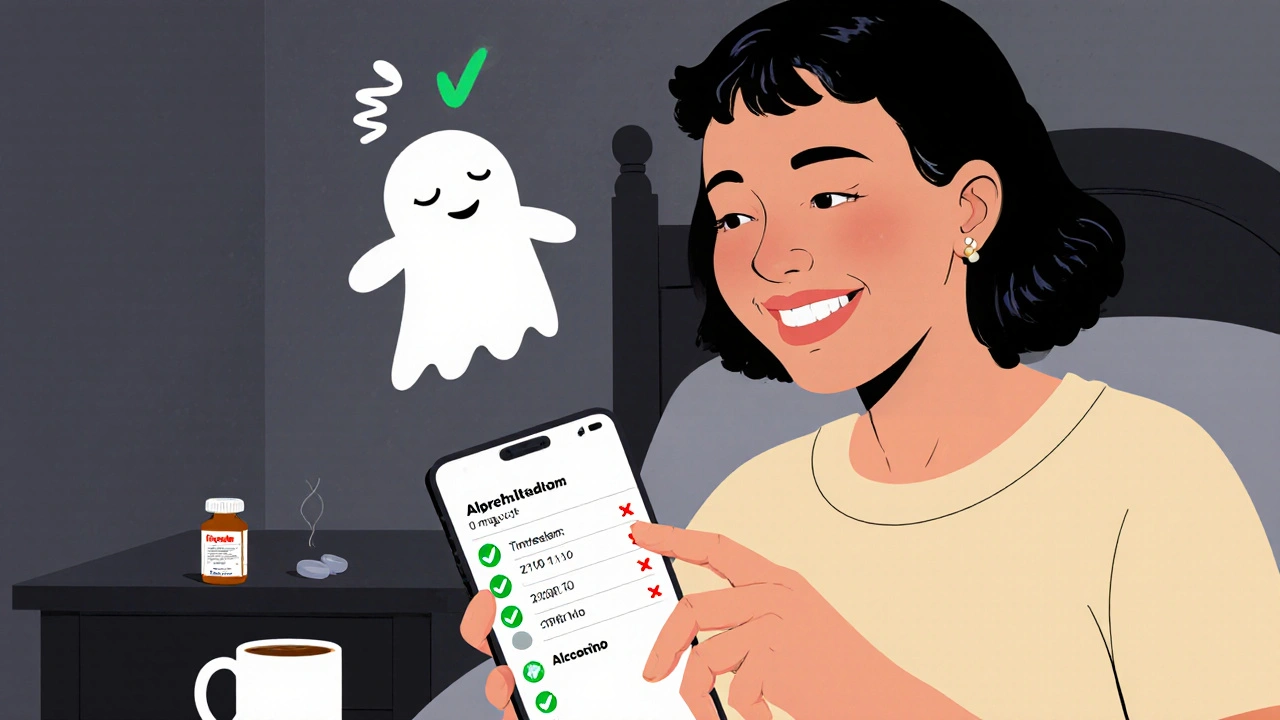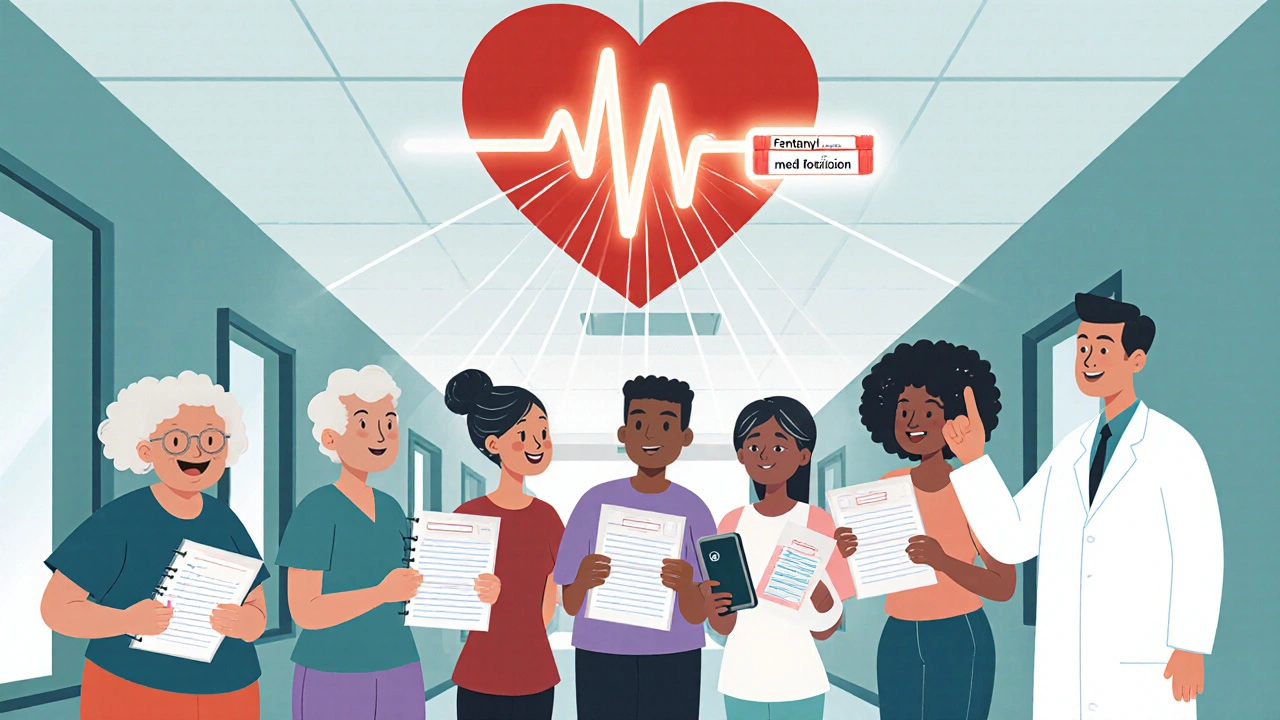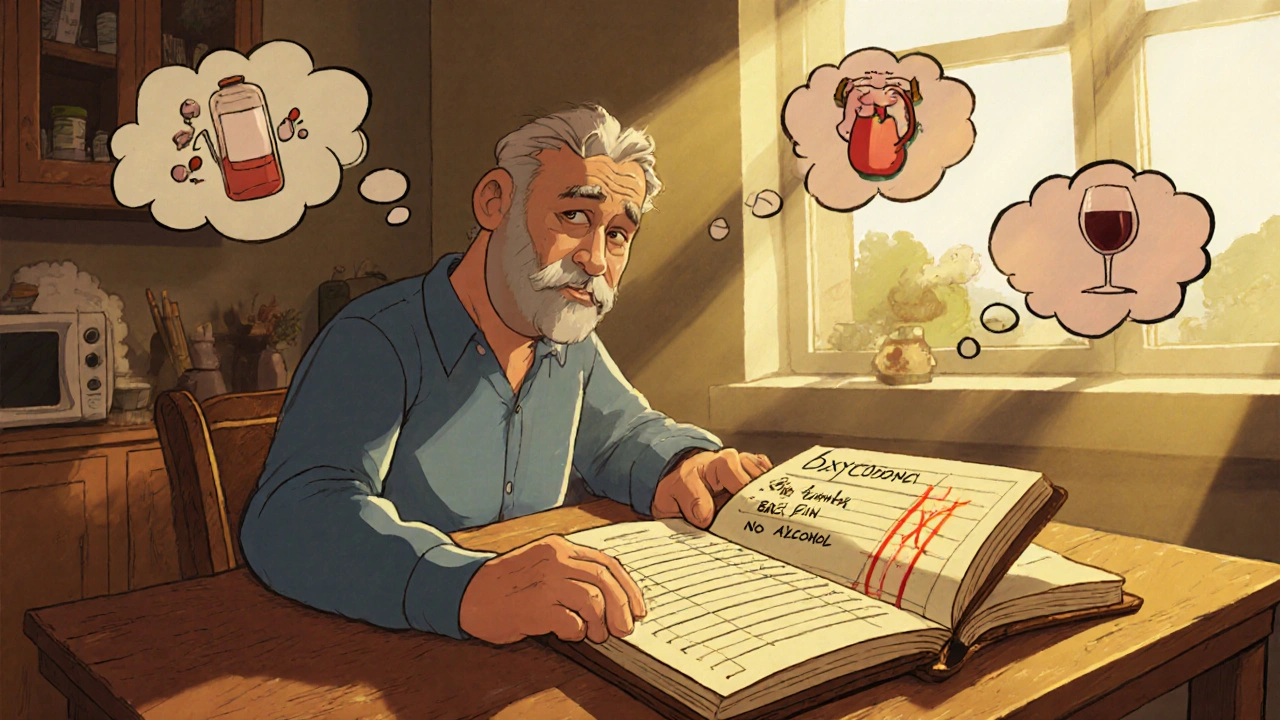Every year, thousands of people accidentally take too much of a medication-sometimes because they lost track of what they took, when they took it, or how much. It’s not always about illegal drugs. It’s often prescription painkillers, sleep aids, anxiety meds, or even over-the-counter pain relievers mixed with alcohol. One missed dose, one extra pill, one forgotten interaction-and it can turn dangerous. But there’s a simple, powerful tool that can stop this before it happens: a medication log.
Why a Medication Log Matters
You don’t need to be on opioids to need a medication log. If you take more than one medication daily-if you ever mix pills with alcohol, sleep aids, or muscle relaxants-you’re at risk. The CDC says combining opioids with benzodiazepines or alcohol increases overdose risk by up to 50%. Many people don’t realize they’re doing it until it’s too late. A medication log isn’t just for doctors. It’s for you. It’s your personal safety net. It answers questions like:- Did I take my painkiller this morning or yesterday?
- How much did I take last night? Was it the 5mg or the 10mg?
- Did I drink alcohol after taking my anxiety pill?
- Did I feel dizzy after taking this combo? Should I avoid it next time?
What to Include in Your Log
A good log doesn’t need to be fancy. Just write down five key things every time you take a medication:- Medication name - Use the brand or generic name you know. Don’t write “the blue pill.” Write “oxycodone 5mg” or “alprazolam 0.5mg.”
- Dose taken - Exact amount. If you split a pill, write “2.5mg” not “half.”
- Time taken - Use 24-hour time if possible. 14:30 is clearer than “2:30 pm.”
- Reason for taking - “For back pain,” “for sleep,” “for anxiety.” This helps you spot patterns.
- Other substances taken - Alcohol? Cigarettes? CBD oil? Even a glass of wine counts. Record it.
Paper or Digital? Pick What Works
You don’t need an app. A notebook works. But here’s what each option gives you:| Method | Pros | Cons |
|---|---|---|
| Paper notebook | Always available, no battery, easy to carry, private | Hard to share, easy to lose, no reminders |
| Phone app (e.g., Medisafe, MyTherapy) | Reminders, cloud backup, easy to share with family or doctor | Requires charging, can be distracting, privacy concerns |
| Printed template | Structured layout, no learning curve, printable for multiple meds | Still manual, no alerts |

How to Use Your Log to Avoid Overdose
A log is useless if you don’t use it to make smarter choices. Here’s how:- Check before you take anything - Before you swallow a pill, look at your log. Did you take this already today? Are you already feeling drowsy from something else?
- Never guess your dose - If you’re unsure how much you took last night, don’t take more. Wait. Check your log. If you can’t find it, skip it.
- Spot dangerous combos - If you notice you took a sleeping pill and then drank wine three times in the past week, that’s a red flag. Stop. Adjust.
- Use test strips if you use street drugs - If you’re using pills bought outside a pharmacy, use fentanyl test strips. Write down the result in your log. “Pill tested: positive for fentanyl. Took 1/4.”
- Share it with someone you trust - Give a copy to a friend, family member, or support worker. If you’re ever found unresponsive, they’ll know what you took and when.
Common Mistakes and How to Fix Them
People start logs. Then they stop. Here’s why-and how to keep going:- “I forget to write it down.” - Set a daily alarm labeled “Log meds.” Or pair it with something you already do-like brushing your teeth or having coffee.
- “I don’t remember the exact dose.” - Keep your pills in their original bottles. Write the dose from the label, not from memory.
- “I’m embarrassed.” - This isn’t about judgment. It’s about survival. You’re not a bad person for needing this. You’re smart for using it.
- “It’s too much work.” - Start small. Log just your most dangerous meds first. Maybe just your painkiller and your sleep aid. Add others later.
When to Talk to Your Doctor
Your log isn’t just for you. Bring it to appointments. Show your doctor the pattern: “I took 10mg of oxycodone on Monday, then 5mg on Wednesday, and felt dizzy after both. I didn’t take alcohol, but I did take melatonin.” That’s data they can’t get from a pharmacy record. Doctors rely on Prescription Drug Monitoring Programs (PDMPs) to see what prescriptions you’ve filled. But those systems don’t show what you actually took. Your log fills that gap. It tells them if you’re crushing pills, skipping doses, or mixing substances they didn’t know about.
Real-Life Impact
One man in Bristol, 58, took oxycodone for chronic back pain and a benzodiazepine for anxiety. He started logging after his pharmacist warned him about the combo. Within two weeks, he noticed he was taking both at night-twice a week. He felt foggy in the mornings. He stopped the nighttime combo. His energy improved. His risk of overdose dropped. Another woman used heroin occasionally. She started using fentanyl test strips and logging each use: “Date, dose, test result, how I felt.” One day, the strip showed fentanyl. She took only a quarter of her usual dose. She stayed safe. These aren’t rare stories. They’re repeatable strategies.Final Thought: Your Log Is Your Lifeline
Overdose doesn’t always happen because someone wants to die. Often, it happens because someone lost track. One mistake. One forgotten pill. One too many drinks. A medication log turns guesswork into control. It gives you back the power to decide-not just react. You don’t need to be perfect. Just consistent. Even if you only log three times a week, you’re safer than if you don’t log at all. Start today. Grab a notebook. Write down what you’re taking right now. Time. Dose. Why. Anything else you took. That’s it. You’ve just taken your first step to staying alive.Do I need a medication log if I only take one prescription?
Yes-if you take anything else, even over-the-counter pills, supplements, or alcohol. Many overdoses happen from mixing medications, not from taking too much of one. Even a single prescription can be dangerous if combined with sleep aids, pain relievers like acetaminophen, or alcohol. A log helps you spot those hidden risks.
Can I use my phone’s notes app instead of a dedicated app?
Absolutely. Your phone’s notes app, a spreadsheet, or even a voice memo works if it’s consistent. The tool doesn’t matter-what matters is that you record the five key details: medication, dose, time, reason, and other substances. Just make sure you can find it quickly when you need it.
What if I miss a day or two?
Don’t panic. Don’t try to backfill. Just start again. A log that’s 80% complete is far safer than one you abandoned because you missed a day. The goal isn’t perfection-it’s reducing risk. Every entry you make lowers your chance of overdose.
Should I share my log with my family?
If you feel safe doing so, yes. Having someone who knows what you take and when can save your life. If you’re ever unconscious or unresponsive, a trusted person with your log can tell emergency responders exactly what you took, helping them give the right treatment faster.
Is a medication log only for people with opioid use disorder?
No. Anyone taking multiple medications, especially those that cause drowsiness, is at risk. That includes people managing chronic pain, anxiety, insomnia, or arthritis. Overdose doesn’t discriminate by diagnosis. It happens to people who forget, mix, or misjudge. A log helps everyone.
Can a medication log help if I use street drugs?
Yes-especially. Street drugs are unpredictable. Fentanyl is often mixed in without warning. Logging what you took, when, and the test strip result helps you avoid lethal doses. It also helps others if you need help. Harm reduction programs encourage this exact practice.

Jennifer Bedrosian
November 10, 2025 AT 13:26OMG I literally just started logging my meds after my cousin almost died from mixing oxycodone and wine 🙃 I used to think I was fine because I only took one pill but then I realized I was taking it with my nightly glass of chardonnay and my brain was like a fog machine every morning. Now I write it down like a diary. It’s not for the doctor, it’s for me. I’m alive because I stopped guessing.
Lashonda Rene
November 11, 2025 AT 08:52i never thought about how easy it is to forget what you took when you’re tired or in pain or just having one of those days where your brain feels like mush. i started writing down my pain meds and my sleep stuff because i kept taking the wrong dose and then feeling weird the next day. now i just write it on a sticky note next to my coffee maker and it’s so simple. no app, no fancy stuff. just pen and paper. and honestly? it’s made me feel more in control than i have in years.
Erika Puhan
November 11, 2025 AT 19:48The data here is statistically significant but the implementation framework lacks scalability. Most users fail to maintain compliance beyond 14 days due to cognitive load and behavioral fatigue. The absence of behavioral economics nudges-like loss aversion triggers or commitment devices-renders this approach suboptimal for populations with low health literacy. A digital twin with real-time PDMP integration would be more effective than a paper log.
Edward Weaver
November 13, 2025 AT 02:31Why are we even talking about this? In America, you take your meds like an adult or you don’t take them at all. If you can’t remember if you took your pill, maybe you shouldn’t be on it. This whole log thing is just another nanny-state crutch. Get your act together.
Lexi Brinkley
November 14, 2025 AT 11:00THIS. IS. LIFE. CHANGING. 🙌 I started logging after my dad OD’d last year. Now I log everything. Even my ibuprofen. Even my tea with melatonin. I use a little notebook with sparkly pen and I feel like a superhero every time I write it down 💪💊✨
Kelsey Veg
November 16, 2025 AT 07:35the part about fentanyl test strips is legit but most ppl dont know how to use them or where to get them. also why are we assuming everyone has a phone or paper? what about homeless people? or people with tremors? this whole thing is kinda privileged. like yeah great for you with your iphone and your quiet apartment but what about the rest of us?
Alex Harrison
November 17, 2025 AT 03:29i’ve been using a simple spreadsheet on my phone for my anxiety meds and painkillers and it’s been a game changer. i used to forget if i took my 5mg or 10mg and now i just open the sheet and see exactly what i did yesterday. i dont use reminders because i’m bad with them but i just write it down after i brush my teeth. small habit, huge difference. thanks for the post.
Jay Wallace
November 18, 2025 AT 23:01Let me be perfectly clear: this is not a ‘lifestyle hack.’ It’s a necessary clinical protocol. The fact that we’re even discussing paper logs in 2025 is a reflection of systemic healthcare failure. If your doctor isn’t prescribing a digital, HIPAA-compliant, cloud-synced medication tracker with automated interaction alerts, they’re practicing malpractice by omission. Also, ‘alcohol’ is not a valid entry-it’s 14g of ethanol, period.
Alyssa Fisher
November 19, 2025 AT 05:50What’s interesting here is how this log transforms intention into accountability. We don’t just forget doses-we forget our own vulnerability. The log isn’t about remembering pills; it’s about remembering that you matter enough to track your survival. It’s a quiet act of self-respect in a world that tells you to tough it out. And that’s why it works.
Alyssa Salazar
November 20, 2025 AT 15:13As a clinical pharmacist, I’ve seen 17 patients in the last 6 months who overdosed on benzodiazepine-opioid combos they didn’t realize were dangerous. The log isn’t optional-it’s a harm reduction cornerstone. If you’re on any CNS depressant, you’re playing Russian roulette with your brainstem. This isn’t advice. It’s a medical imperative. And if you think you’re ‘too functional’ to need it, you’re already in denial.
Beth Banham
November 21, 2025 AT 09:37i’ve been doing this for 8 months now. just a little notebook in my purse. i don’t write every day, but when i do, i feel calmer. like i’m not just floating through life taking random pills. i’m making choices. it’s not about being perfect. it’s about being present. thank you for writing this.
Brierly Davis
November 23, 2025 AT 05:33you got this 💪 i know it feels like a chore at first but trust me, after a week it becomes second nature. i started with just my pain meds and sleep aid-two lines a day. now i log everything. even my vitamin D. i use a voice note while brushing my teeth. no typing, no stress. just say it out loud and let your phone record it. you’re not failing-you’re building a habit. and that’s huge.
Amber O'Sullivan
November 24, 2025 AT 03:07log it or lose it. simple. no need for apps or fancy templates. pen paper time dose reason. done. if you cant do that then maybe you shouldnt be mixing meds. its not complicated. stop overthinking it.
Jim Oliver
November 24, 2025 AT 06:29Wow. A whole article about writing things down. Groundbreaking. Next up: ‘How to Use a Calendar to Remember Your Birthday.’ Maybe we should also teach people not to drink and drive? Or breathe air? This is the pinnacle of public health innovation.
William Priest
November 25, 2025 AT 07:14As a former addict who’s been clean for 12 years, I can confirm: this log saved my life. I didn’t just write down pills-I wrote down how I felt, who I was with, what I was avoiding. It became a mirror. And sometimes, the truth in that mirror is the only thing that keeps you from falling back. Don’t just log your meds. Log your humanity.